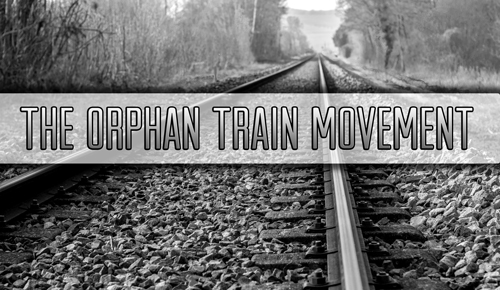Throughout the entire history of America, federal, local, and state governments have regularly undertaken programs to promote the welfare and betterment of their citizens, and the largest city in the country, New York City, is no exception. During the course of its existence, the large, five-borough metropolitan area has seen countless efforts to improve the lives of the people who call it home. One of those programs, which ended up being particularly controversial, was dubbed The Orphan Train Movement, and it resulted in the uprooting of more than 120,000 children from the streets of New York.
The Orphan Train movement was started by a man named Charles Loring Brace in 1853. Brace was a minister, and he was upset by the plight of the more than 30,000 homeless children that were living on the city’s streets. To help the children, he founded the Children’s Aid Society and devised a plan for the organization to remove the children from the streets and send them by train, to live with families on farms in rural areas. The children would be brought for free but would exist as an extra pair of hands to help out at their new homes.
Between 1854 and 1929, approximately 120,000 children were transported by train out of New York. The children were taken in groups – between 10 and 40 children – with a supervising agent to a train. The trains were then sent to farms across the country, and some even across international borders to Canada and Mexico. Along the way, children were dropped off at their respective new towns and homes. Homes and homeowners were screened to see that they were fit to take care of children. Many children who were transported to new homes via an Orphan Train had a hard adjustment. For children who knew nothing but New York City streets, farms in states like Indiana or Nebraska were a shocking change. Despite the transitional challenges, many children who were placed in the Orphan Train program flourished in their new lives. Many had successful careers, and several went on to be governors, congressmen, and district attorneys and hold other powerful positions.
The Orphan Train Movement certainly helped improve the lives of children who ultimately would have lived in destitution. It was not, however, without its critics. Many people felt that seizing children from their lives and taking them somewhere unfamiliar was traumatic and unfair. Others believed that it promoted slavery because the children were often put to work when they arrived at the farms.
The Orphan Train program ran for nearly 75 years and did not cease entirely until 1929. There were many reasons the program stopped, but the biggest was that state laws began to forbid the transporting of children interstate, which meant far less access to rural areas and homes that had the space and the need for an extra child. However, while the Orphan Train Program technically ended, its influence continues today. Many people believe the movement to be the precursor to the current foster care program that exists in the country, and it’s also thought to be the precursor to many of America’s youth-welfare programs, like public schools and health care provisions.
Do you think that the Orphan Train Program was a successful one? How do you think it compares to the foster care system that exists in America today?
Here are a few excellent books if you would like to learn more about the Orphan Trains:
- Patrick, Michael, Evelyn Sheets, and Evelyn Trickel. We Are A Part of History. Santa Fe N. Mex.: Lightning Tree Press, 1990.
- Vogt, Martha Nelson, and Christina Vogt. Searching for Home: Three Families from the Orphan Trains. Grand Rapid, Mich.: Triumph Press, 1986.
- Johnson, Mary Ellen (ed.) Orphan Train Riders: Their Own Stories, volumes I-V. Baltimore, Md.: Gateway Press, 1992, 1993, 1995, 1996.
- Warren, Andrea. Orphan Train Rider – One Boy's True Story. Houghton Mifflin Co. Boston, 1996.





